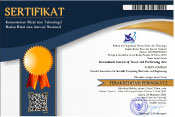*corresponding author
AbstractVisual imagery is the most important part of game design. Game designers should pay particular attention so that the visual character of the game can be effectively realized and able to convey the depth of its visual meanings. Taking use of the widespread fear of the Indonesian Ghost's appearance, the game is able to present challenges to its players. This study aims to develop the creation of character designs, especially by elevating visual images of Indonesian ghosts into visual characters' in-game media. The method for designing Indonesian ghost characters is to dismantle the visual image of Indonesian ghost characters in the Dreadeye VR game. The strategy is to consider the following three components: (1) the matrix of shapes, (2) the costume matrix, and (3) the matrix of traits. All three were analyzed with the approach of manga matrix theory. This research has led to the emergence of relatively distinct ghost figures that are frequently feared by Indonesians, such as pocong, kuntilanak, and tuyul. By examining the matrices of the shape, costume, and nature of each character of the three Indonesian ghosts, it is possible to conclude that to create visual characters of Indonesian ghosts, game designers must identify these three components, while the contribution of this research is to provide a visual image analysis model including shape imagery, costume imagery, and traits imagery of Indonesian ghosts used in the Dreadeye VR Game in Indonesia.
KeywordsGame; Indonesian ghost; Visual characters; Manga Matrix; Dreadeye VR
|
DOIhttps://doi.org/10.31763/viperarts.v4i1.655 |
Article metrics10.31763/viperarts.v4i1.655 Abstract views : 1775 | PDF views : 667 |
Cite |
Full Text Download Download
|
References
[1] G. Tavinor, The art of videogames. John Wiley & Sons, 2009. doi: 10.1002/9781444310177
[2] S. Egenfeldt-Nielsen, J. H. Smith, and S. P. Tosca, Understanding video games: The essential introduction. Routledge, 2013. doi: 10.4324/9780203116777
[3] M. McLuhan and H. Parker, From Blast to Counterblast. Berlin: Harcourt, Brace & World New York, 1969. Available at: neocities.
[4] S. Kiryakos and S. Sugimoto, “Building a bibliographic hierarchy for manga through the aggregation of institutional and hobbyist descriptions,†J. Doc., vol. 75, no. 2, pp. 287–313, Mar. 2019, doi: 10.1108/JD-06-2018-0089.
[5] K. Oishi, T. Mihara, M. Nagamori, and S. Sugimoto, “Identifying and Linking Entities of Multimedia Franchise on Manga, Anime and Video Game from Wikipedia,†in International Conference on Asian Digital Libraries, 2019, pp. 95–101. doi: 10.1007/978-3-030-34058-2_10
[6] T. Singhal and O. Schneider, “Juicy Haptic Design: Vibrotactile Embellishments Can Improve Player Experience in Games,†in Proceedings of the 2021 CHI Conference on Human Factors in Computing Systems, 2021, pp. 1–11, doi: 10.1145/3411764.3445463.
[7] B. De Paula, “Exploring game grammars: a sociosemiotic account of young people’s game-making practices,†Vis. Commun., vol. 0, no. 0, pp. 1–20, Sep. 2021, doi: 10.1177/14703572211027214.
[8] A. Soraya and Y. S. Martyastiadi, “Aesthetics of Virtual: The Development Opportunities of Virtual Museums in Indonesia,†Int. J. Creat. Arts Stud., vol. 8, no. 1, pp. 25–33, Jun. 2021, doi: 10.24821/ijcas.v8i1.5346.
[9] Y. Nara, G. Kunitomi, Y. Koide, W. Fujimura, and A. Shirai, “Manga generator: immersive posing role playing game in manga world,†in Proceedings of the Virtual Reality International Conference: Laval Virtual, 2013, pp. 1–5, doi: 10.1145/2466816.2466845.
[10] C. Oliva, “The Musical Ludo Mix of Taiko no Tatsujin,†Trans. Digit. Games Res. Assoc., vol. 5, no. 2, pp. 131–160, Apr. 2021, doi: 10.26503/todigra.v5i2.118.
[11] M. Steinberg, “8-Bit Manga: Kadokawa’s Madara, or, the Gameic media mix,†Kinephanos J. Media Stud. Pop. Cult., vol. 5, no. 1, pp. 40–52, 2015. Available at: Google Scholar.
[12] D. M. Oóhagan, “Manga, anime and video games: Globalizing Japanese cultural production,†Perspectives (Montclair)., vol. 14, no. 4, pp. 242–247, Jul. 2007, doi: 10.1080/09076760708669041.
[13] M. Fanasca, “When girls draw the sword: DansÅ , cross-dressing and gender subversion in Japanese shÅjo manga,†Queer Stud. Media Pop. Cult., vol. 6, no. 1, pp. 3–18, Mar. 2021, doi: 10.1386/qsmpc_00041_1.
[14] O. Woods, “The affective embeddings of gacha games: Aesthetic assemblages and the mediated expression of the self,†New Media Soc., vol. 0, no. 0, pp. 1–16, Jan. 2022, doi: 10.1177/14614448211067756.
[15] X. Liu, C. Li, H. Zhu, T.-T. Wong, and X. Xu, “Text-aware balloon extraction from manga,†Vis. Comput., vol. 32, no. 4, pp. 501–511, Apr. 2016, doi: 10.1007/s00371-015-1084-0.
[16] N.-V. Nguyen, C. Rigaud, A. Revel, and J.-C. Burie, “Manga-MMTL: Multimodal Multitask Transfer Learning for Manga Character Analysis,†in International Conference on Document Analysis and Recognition, Springer, 2021, pp. 410–425. doi: 10.1007/978-3-030-86331-9_27
[17] Y. Li, Y. Zhou, Y. Wang, X. Qin, and Z. Tang, “Dual Loss for Manga Character Recognition with Imbalanced Training Data,†in 2020 25th International Conference on Pattern Recognition (ICPR), 2021, pp. 2166–2171, doi: 10.1109/ICPR48806.2021.9412282.
[18] T. Winge, “Costuming the imagination: Origins of anime and manga cosplay,†Mechademia, vol. 1, no. 1, pp. 65–76, 2006, doi: 10.1353/mec.0.0084.
[19] M. Iskandar and S. Nurusholih, “‘ Lacerman’ Comic Character Design With Morphological Forced Connection Method (Mfc),†Balong Int. J. Des., vol. 2, no. 2, pp. 84–92, 2019. doi: 10.25134/balong.v2i2.2422
[20] K. Gao, S. Zheng, D. L. Lee, D. Y. Lee, and H. B. Huang, “Design Method of the Form of Fantasy Game Characters,†in Knowledge Innovation on Design and Culture: Proceedings of the 3rd IEEE International Conference on Knowledge Innovation and Invention 2020 (IEEE ICKII 2020), 2022, pp. 113–116, doi: 10.1142/9789811238727_0027.
[21] H. Tsukamoto, Manga Matrix: Create unique characters using the Japanese matrix system. Collins Design, 2006. Available at: Google Scholar.
[22] T. Tsukamoto, T. Kambe, T. Imaoka, and K. Yamamoto, “Modern cluster design based on experiment and theory,†Nat. Rev. Chem., vol. 5, no. 5, pp. 338–347, May 2021, doi: 10.1038/s41570-021-00267-4.
Refbacks
- There are currently no refbacks.
Copyright (c) 2022 Ricky Widyananda Putra

This work is licensed under a Creative Commons Attribution-ShareAlike 4.0 International License.
___________________________________________________________
International Journal of Visual and Performing Arts
ISSN 2684-9259
Published by Association for Scientific Computing Electronics and Engineering (ASCEE)
W: http://pubs2.ascee.org/index.php/viperarts
E: sularso@ascee.org
Organized by:
 This work is licensed under a Creative Commons Attribution-ShareAlike 4.0
This work is licensed under a Creative Commons Attribution-ShareAlike 4.0
























